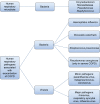Bacterial-viral load and the immune response in stable and exacerbated COPD: significance and therapeutic prospects
- PMID: 27042037
- PMCID: PMC4780195
- DOI: 10.2147/COPD.S93398
Bacterial-viral load and the immune response in stable and exacerbated COPD: significance and therapeutic prospects
Abstract
Chronic obstructive pulmonary disease (COPD) is characterized by persistent airflow limitation and an abnormal inflammatory response of the lung. Bacteria and viruses are a major cause of COPD exacerbations and may contribute to COPD progression by perpetuating the inflammatory response in the airways. Bacterial variety diminishes with increasing COPD severity. Respiratory viruses can colonize the lower respiratory tract in stable COPD, altering the respiratory microbiome and facilitating secondary bacterial infections. In this review, we present the most updated information about the role of bacteria and viruses in stable and exacerbated COPD. In our opinion, to optimize therapeutic strategies, the dynamic events involving bacterial-viral infections and related immune response in COPD phenotypes need to be better clarified. Our paper would address these points that we consider of great importance for the clinical management of COPD.
Keywords: COPD phenotype; biomarkers; exacerbations; microbiome; severity of COPD.
Figures


Similar articles
-
Bacterial and viral infections and related inflammatory responses in chronic obstructive pulmonary disease.Ann Med. 2021 Dec;53(1):135-150. doi: 10.1080/07853890.2020.1831050. Ann Med. 2021. PMID: 32997525 Free PMC article. Review.
-
Role of airway glucose in bacterial infections in patients with chronic obstructive pulmonary disease.J Allergy Clin Immunol. 2018 Sep;142(3):815-823.e6. doi: 10.1016/j.jaci.2017.10.017. Epub 2018 Jan 5. J Allergy Clin Immunol. 2018. PMID: 29310905 Free PMC article.
-
Prophylactic antibiotics for adults with chronic obstructive pulmonary disease: a network meta-analysis.Cochrane Database Syst Rev. 2021 Jan 15;1(1):CD013198. doi: 10.1002/14651858.CD013198.pub2. Cochrane Database Syst Rev. 2021. PMID: 33448349 Free PMC article.
-
The lung microbiome dynamics between stability and exacerbation in chronic obstructive pulmonary disease (COPD): Current perspectives.Respir Med. 2019 Oct;157:1-6. doi: 10.1016/j.rmed.2019.08.012. Epub 2019 Aug 21. Respir Med. 2019. PMID: 31450162 Review.
-
Microbial burden and viral exacerbations in a longitudinal multicenter COPD cohort.Respir Res. 2020 Mar 30;21(1):77. doi: 10.1186/s12931-020-01340-0. Respir Res. 2020. PMID: 32228581 Free PMC article.
Cited by
-
Airway pathogens detected in stable and exacerbated COPD in patients in Asia-Pacific.ERJ Open Res. 2022 Sep 26;8(3):00057-2022. doi: 10.1183/23120541.00057-2022. eCollection 2022 Jul. ERJ Open Res. 2022. PMID: 36171985 Free PMC article.
-
Th17 profile in COPD exacerbations.Int J Chron Obstruct Pulmon Dis. 2017 Jun 22;12:1857-1865. doi: 10.2147/COPD.S136592. eCollection 2017. Int J Chron Obstruct Pulmon Dis. 2017. PMID: 28694696 Free PMC article. Review.
-
Participation of ABCA1 Transporter in Pathogenesis of Chronic Obstructive Pulmonary Disease.Int J Mol Sci. 2021 Mar 24;22(7):3334. doi: 10.3390/ijms22073334. Int J Mol Sci. 2021. PMID: 33805156 Free PMC article. Review.
-
The Anti-Inflammatory Effect of Lactose-Modified Hyaluronic Acid Molecules on Primary Bronchial Fibroblasts of Smokers.Polymers (Basel). 2023 Mar 24;15(7):1616. doi: 10.3390/polym15071616. Polymers (Basel). 2023. PMID: 37050230 Free PMC article.
-
Mortality, seasonal variation, and susceptibility to acute exacerbation of COPD in the pandemic year: a nationwide population study.Ther Adv Respir Dis. 2022 Jan-Dec;16:17534666221081047. doi: 10.1177/17534666221081047. Ther Adv Respir Dis. 2022. PMID: 35253548 Free PMC article.
References
-
- Global Initiative for Chronic Obstructive Lung Disease (GOLD): global strategy for the diagnosis, management and prevention of chronic obstructive pulmonary disease; NHLBI/WHO workshop report; NIH Publication No 2701A. Last update 2015. Available from: http://www.goldcopd.com. - PubMed
-
- Di Stefano A, Caramori G, Ricciardolo FLM, Capelli A, Adcock IM, Donner CF. Cellular and molecular mechanisms in chronic obstructive pulmonary disease: an overview. Clin Exp Allergy. 2004;34:1156–1167. - PubMed
-
- Papi A, Bellettato CM, Braccioni F, et al. Infections and airway inflammation in chronic obstructive pulmonary disease severe exacerbations. Am J Respir Crit Care Med. 2006;173:1114–1121. - PubMed
-
- Bafadhel M, McKenna S, Terry S, et al. Acute exacerbations of chronic obstructive pulmonary disease identification of biologic clusters and their biomarkers. Am J Respir Crit Care Med. 2011;184:662–671. - PubMed
Publication types
MeSH terms
LinkOut - more resources
Full Text Sources
Other Literature Sources
Medical

